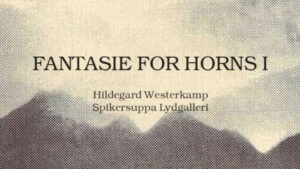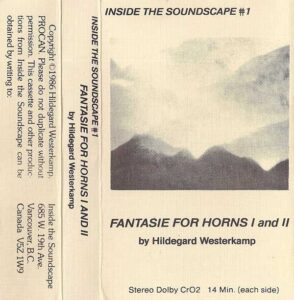Fantasie for Horns I av Hildegard Westerkamp (1978)
Spikersuppa lydgalleri

Fantasie for Horns I av Hildegard Westerkamp (1978)
Spikersuppa lydgalleri
Karl Johans gt. 41B, 0162 Oslo
11. januar – 3. mars 2025
Mandag – fredag kl. 16.00, 17.00, 18.30 og 20.00
Lørdag – søndag kl. 12.00, 13.00, 15.00, 17.00 og 19.00
Varighet: 13 minutter og 2 sekunder
Den kanadiske komponisten Hildegard Westerkamp (f.1946) er en av de mest betydningsfulle skikkelsene innen lydlandskapskomposisjon og akustisk økologi. Sistnevnte omhandler hvordan forholdet mellom mennesket og dets miljø kan komme til uttrykk via lyd, mens lydlandskapskomposisjoner handler om å formidle opplevelsen av et sted gjennom lyd. Westerkamp er interessert i hvordan lyder formes og endres av omkringliggende landskap, og mange av hennes komposisjoner handler om det akustiske miljøet. Karakteristisk for Westerkamp er sammenstillingen av opptak, stemmer og live instrumenter, noe som blant annet har medført at komposisjonene hennes kjennetegnes mer av lyd enn det som vanligvis regnes som musikk.
Fantasie for Horns I, som presenteres i Spikersuppa lydgalleri vinteren 2025, er basert på lyder fra togfløyter, båthorn, fabrikksignaler og tåkelurer på både stillehavskysten og atlanterhavskysten i Canada. Her fikk hvert horn fikk sin unike lyd fra landskapet det tilhørte, hvor lyden ble formet og modulert av omkringliggende landskapsformer.
Grunnlaget for Fantasie for Horns I er i stor grad opptak fra World Soundscape Project’s collection of environmental sound recordings at Simon Fraser University in Vancouver, B.C., i kombination med kunstnerens egne opptak av hornlyder langs den kanadiske kysten på 1970-tallet hvor de utgjorde en naturlig del av lydlandskapet og hverdagen til menneskene som bodde der. Gjennom de neste tiårenes teknologiutvikling forsvant de gradvis sammen med automatiseringen av blant annet fyrtårnene. I dag er ikke lenger disse hornlydene en del av de kanadiske kystlandskapene. Det åpner for refleksjoner rundt de mer subtile endringene i miljøet vårt og hvordan dette har innvirkning på oss. Hva er det vi mister, og hva er det vi får?
Utdøende lyder og stedsfornemmelser
Mesteparten av materialet i Fantasie for Horns I er hentet fra World Soundscape sin samling lydopptak av kystmiljøet i Canada. World Soundscape Project var et internasjonalt forskningsprosjekt som ble ledet av den kanadiske komponisten R. Murray Schafer ved Simon Fraser University. For Westerkamp, som ble med i prosjekt raskt etter fullført utdanning, ble dette en særlig formgivende periode. Gjennom sin deltakelse i prosjektet, dannet Westerkamp samtidig grunnlaget for måten hun skulle tenke om musikk på, og lytte og skape den.
World Soundscape Project representerer også oppstarten av det moderne studiet av akustisk økologi. Med fokus på å finne løsninger for balanserte lydlandskap og støyforurensning, resulterte også i en stor lydbank som blant annet bevarer utdøende lyder og lydmiljøer.
For Westerkamp var det særlig måten lydene interagerte med landskapet som inspirerte henne til å arbeide videre med det innsamlede materialet. Å lytte til de ulike hornene i samlingen av opptak var fascinerende på grunn av måten lydene deres endret seg i takt med landskapet. Noen horn hadde bare ett ekko, mens andre hadde mange, og lydene deres forsvant sakte i det fjerne. Et tåkehorn hadde et ekko som var en oktav lavere enn den faktiske lyden, et annet var en oktav høyere.
Hornlyder er også interessante fordi de skjærer gjennom enhver bakgrunnslyd, selv i store byer. De fungerer som lydmerker som gir et sted karakter og gir oss, ofte ubevisst, en stedsfornemmelse.
Hildegard Westerkamp (f.1946) er en kanadisk komponist, radioartist, lærer og akustisk økolog av tysk opprinnelse. Hun har utdannelse i musikkstudier fra University of British Columbia og ble tidlig en del av World Soundscape Project under ledelse av R. Murray Schafer ved Simon Fraser University. Hun avholdt også ukentlige lydvandringer på radiokanalen Vancouver Co-operative Radio, noe som bidro sterkt til retningen hennes videre karriere skulle ta. Hun var i 1993 med på å etablere World Forum for Acoustic Ecology, var sjefredaktør for tidsskriftet Soundscape fra 2000 til 2012, har skrevet en rekke fagartikler og reist verden rundt med foredrag og workshops om lydlandskaper.
_____
_____
Fantasie for Horns I by Hildegard Westerkamp (1978)
Spikersuppa Sound Gallery
Dates: January 11 – March 3, 2025
Times:
- Monday–Friday: 4:00 PM, 5:00 PM, 6:30 PM, 8:00 PM
- Saturday–Sunday: 12:00 PM, 1:00 PM, 3:00 PM, 5:00 PM, 7:00 PM
Duration: 13 minutes and 2 seconds
The Canadian composer Hildegard Westerkamp (b. 1946) is one of the most significant figures in soundscape composition and acoustic ecology. The latter explores how the relationship between humans and their environment can be expressed through sound, while soundscape compositions aim to convey the experience of a place through sound. Westerkamp is particularly interested in how sounds are shaped and transformed by the surrounding landscape, and many of her compositions explore the acoustic environment. Her work is characterized by the interplay of field recordings, voices, and live instruments, often resulting in compositions defined more by sound than what is traditionally considered music.
Fantasie for Horns I, featured at Spikersuppa Sound Gallery in the winter of 2025, is based on sounds from train whistles, ship horns, factory signals, and foghorns along Canada’s Pacific and Atlantic coasts. Each horn produced a unique sound shaped by the landscape to which it belonged, with the surrounding terrain modulating and transforming its tone.
The foundation of Fantasie for Horns I lies in recordings from World Soundscape Project’s collection of environmental sound recordings at Simon Fraser University in Vancouver, B.C., some of it was the artist’s own recordings of horn sounds along the Canadian coastline in the 1970s, where they formed a natural part of the soundscape and the daily lives of the people who lived there. Over the following decades, technological advancements gradually silenced these sounds, particularly through the automation of lighthouses. Today, these horn sounds are no longer part of Canada’s coastal soundscapes. This absence invites reflection on the subtler changes in our environment and how they affect us. What do we lose, and what do we gain?
Disappearing Sounds and Sense of Place
Much of the material in Fantasie for Horns I originates from the World Soundscape Project’s collection of recordings of Canada’s coastal environments. The World Soundscape Project was an international research initiative led by Canadian composer R. Murray Schafer at Simon Fraser University. For Westerkamp, who joined the project shortly after completing her education, this was a particularly formative period. Her participation in the project shaped her approach to music, listening, and creating.
The World Soundscape Project also marks the beginning of modern acoustic ecology. Its focus on finding solutions for balanced soundscapes and reducing noise pollution resulted in a substantial archive of recordings, preserving both endangered sounds and sound environments.
For Westerkamp, the way sounds interacted with the landscape was particularly inspiring, motivating her to work further with the collected material. Listening to the various horns in the collection was fascinating because their sounds changed in response to the landscape. Some horns had only one echo, while others had many, with the sounds gradually fading into the distance. One foghorn produced an echo an octave lower than the original sound, while another was an octave higher.
Horn sounds are also intriguing because they cut through any background noise, even in large cities. They act as auditory landmarks, giving a place its character and providing us—often unconsciously—with a sense of place.
About Hildegard Westerkamp
Hildegard Westerkamp (b. 1946) is a Canadian composer, radio artist, teacher, and acoustic ecologist of German origin. She studied music at the University of British Columbia and became an early member of the World Soundscape Project under the leadership of R. Murray Schafer at Simon Fraser University. She also hosted weekly soundwalks on Vancouver Co-operative Radio, which had a significant impact on the direction of her career.
In 1993, she co-founded the World Forum for Acoustic Ecology. She served as editor-in-chief of the journal Soundscape from 2000 to 2012, authored numerous scholarly articles, and has traveled globally, delivering lectures and workshops on soundscapes.
You can see the water from spikersuppa

